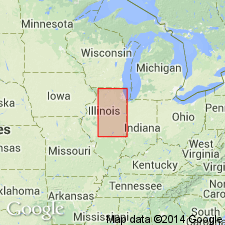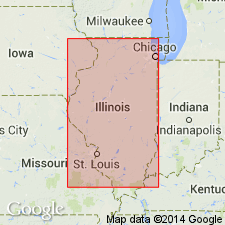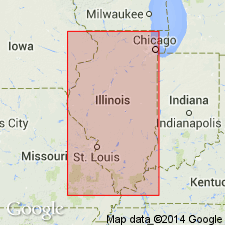
- Usage in publication:
-
- Meadow Loess Member
- Modifications:
-
- Original reference
- Dominant lithology:
-
- Loess
- AAPG geologic province:
-
- Illinois basin
Summary:
Pg. 63; Illinois Bull., no. 95, p. 225, 1975. Meadow Loess Member of Roxana Silt. Loess. Thickness a few feet to 43 feet. Where thick along bluffs of Illinois and Mississippi Rivers of central and southern Illinois it has 3 zones: pink-tan zones at top and base and a gray-tan zone in middle. Rests on Pleasant Grove Soil developed in the McDonough Loess Member of Roxana, or on older deposits. Underlies the in-situ Farmdale Soil, the Robein Silt, or younger formations. Where thick and calcareous, it carries fossil mollusks and has been radiocarbon dated at several localities (see Leonard and Frye, 1960, Illinois Geol. Survey Circ., no. 304, 32 p.). Age is Pleistocene (Wisconsinan Age; Atltonian Subage).
Type section: Pleasant Grove School section, in borrow pits and roadcuts 1.6 km southeast of McDonough Lake, in SW/4 NE/4 SE/4 sec. 20, T. 3 N., R. 8 W., Madison Co., south-central IL. Named from Meadow Heights, part of Collinsville, Madison Co., south-central IL.
Source: Publication; Hdbk Illinois stratigraphy (Illinois Geol. Survey Bull. 95, p. 225); US geologic names lexicon (USGS Bull. 1520, p. 198).

- Usage in publication:
-
- Meadow Loess Member
- Modifications:
-
- Overview
- AAPG geologic province:
-
- Illinois basin
Summary:
The lower Markham Silt Member, upper Meadow Loess Member, and an informal sandy-silt facies are recognized in the Roxana Silt. The McDonough Loess Member and associated Pleasant Grove Soil are probably not valid units according to authors and are not recognized in this study. The Markham is composed of leached, pedogenically altered material. Contains a moderate amount of sand and traces of gravel. Contains more silt, vermiculite, and unweathered minerals than the underlying Glasford Formation. The Meadow Loess Member composes the uppermost 80 to 90 percent of the Roxana. It consists of calcareous and oxidized massive silt loam. The informal sandy-silt facies composes the entire Roxana in eastern IL. Though lithologically similar to the Markham, it is not temporally correlative.
Source: GNU records (USGS DDS-6; Reston GNULEX).

- Usage in publication:
-
- Meadow Member*
- Modifications:
-
- Overview
- AAPG geologic province:
-
- Illinois basin
Summary:
Pg. 15, 52, 102-103. Meadow Member of Roxana Silt of Mason Group. In Bellefontaine quarry section (reference section for the Roxana) is a brown silt loam, 8.5 feet (2.6 m) thick, overlying Markham Member of Roxana and underlying Peoria Silt. [Age is considered Pleistocene (Wisconsinan Age; Woodfordian Subage), based on age of Roxana Silt.]
Source: Publication.
For more information, please contact Nancy Stamm, Geologic Names Committee Secretary.
Asterisk (*) indicates published by U.S. Geological Survey authors.
"No current usage" (†) implies that a name has been abandoned or has fallen into disuse. Former usage and, if known, replacement name given in parentheses ( ).
Slash (/) indicates name conflicts with nomenclatural guidelines (CSN, 1933; ACSN, 1961, 1970; NACSN, 1983, 2005, 2021). May be explained within brackets ([ ]).

